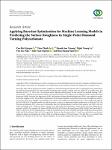Item Infomation

| Title: |
| Applying Bayesian Optimization for Machine Learning Models in Predicting the Surface Roughness in Single-Point Diamond Turning Polycarbonate |
| Authors: |
| Van-Hai Nguyen Tien-Thinh Le Hoanh-Son Truong Minh Vuong Le Van-Luc Ngo Anh Tuan Nguyen Huu Quang Nguyen |
| Issue Date: |
| 2021 |
| Publisher: |
| Mathematical Problems in Engineering |
| Abstract: |
| This paper deals with the prediction of surface roughness in manufacturing polycarbonate (PC) by applying Bayesian optimization for machine learning models. The input variables of ultraprecision turning—namely, feed rate, depth of cut, spindle speed, and vibration of the X-, Y-, and Z-axis—are the main factors affecting surface quality. In this research, six machine learning- (ML-) based models—artificial neural network (ANN), Cat Boost Regression (CAT), Support Vector Machine (SVR), Gradient Boosting Regression (GBR), Decision Tree Regression (DTR), and Extreme Gradient Boosting Regression (XGB)—were applied to predict the surface roughness (Ra). The predictive performance of the baseline models was quantitatively assessed through error metrics: root means square error (RMSE), mean absolute error (MAE), and coefficient of determination (R2). The overall results indicate that the XGB and CAT models predict Ra with the greatest accuracy. In improving baseline models such as XGB and CAT, the Bayesian optimization (BO) is next used to determine their best hyperparameters, and the results indicate that XGB is the best model according to the evaluation metrics. Results have shown that the performance of the models has been improved significantly with BO. For example, the values of RMSE and MAE of XGB have decreased from 0.0076 to 0.0047 and from 0.0063 to 0.0027, respectively, for the training dataset. Using the testing dataset, the values of RMSE and MAE of XGB have decreased from 0.4033 to 0.2512 and from 0.2845 to 0.2225, respectively. Moreover, the vibrations of the X, Y, and Z axes and feed rate are the most significant feature in predicting the results, which is in high accordance with the literature. We find that, in a specified value domain, the vibration of the axes has a greater influence on the surface quality than does the cutting condition. |
| URI: |
| https://www.hindawi.com/journals/mpe/2021/6815802/ https://dlib.phenikaa-uni.edu.vn/handle/PNK/2837 |
| Appears in Collections |
| Bài báo khoa học |
ABSTRACTS VIEWS
171
FULLTEXT VIEWS
14
Files in This Item:
